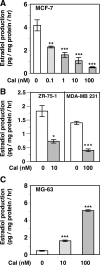Tissue-selective regulation of aromatase expression by calcitriol: implications for breast cancer therapy
- PMID: 19906814
- PMCID: PMC2803154
- DOI: 10.1210/en.2009-0855
Tissue-selective regulation of aromatase expression by calcitriol: implications for breast cancer therapy
Abstract
Aromatase, the enzyme that catalyzes estrogen synthesis, is critical for the progression of estrogen receptor-positive breast cancer (BCa) in postmenopausal women. We show that calcitriol, the hormonally active form of vitamin D, regulates the expression of aromatase in a tissue-selective manner. Calcitriol significantly decreased aromatase expression in human BCa cells and adipocytes and caused substantial increases in human osteosarcoma cells (a bone cell model exhibiting osteoblast phenotype in culture) and modest increases in ovarian cancer cells. Calcitriol administration to immunocompromised mice bearing human BCa xenografts decreased aromatase mRNA levels in the tumors and the surrounding mammary adipose tissue but did not alter ovarian aromatase expression. In BCa cells, calcitriol also reduced the levels of prostaglandins (PGs), major stimulators of aromatase transcription, by suppressing the expression of cyclooxygenase-2 (which catalyzes PG synthesis) and increasing that of 15-hydroxyprostaglandin dehydrogenase (which catalyzes PG degradation). The mechanism of aromatase down-regulation by calcitriol in BCa cells is therefore 2-fold: a direct repression of aromatase transcription via promoter II through the vitamin D-response elements identified in this promoter and an indirect suppression by reducing the levels of PGs. Combinations of calcitriol with three different aromatase inhibitors (AIs) caused enhanced inhibition of BCa cell growth. The combination of calcitriol and an AI may have potential benefits for BCa therapy. In addition to augmenting the ability of AIs to inhibit BCa growth, calcitriol acting as a selective aromatase modulator that increases aromatase expression in bone would reduce the estrogen deprivation in bone caused by the AIs, thus ameliorating the AI-induced side effect of osteoporosis.
Figures






References
-
- Simpson ER, Clyne C, Rubin G, Boon WC, Robertson K, Britt K, Speed C, Jones M 2002 Aromatase—a brief overview. Annu Rev Physiol 64:93–127 - PubMed
-
- Chen S 1998 Aromatase and breast cancer. Front Biosci 3:d922–d933 - PubMed
-
- Brodie A, Long B, Lu Q 1998 Aromatase expression in the human breast. Breast Cancer Res Treat 49(Suppl 1):S85–91; discussion S109–S119 - PubMed
-
- Brueggemeier RW 2006 Update on the use of aromatase inhibitors in breast cancer. Expert Opin Pharmacother 7:1919–1930 - PubMed
-
- Geisler J, Lønning PE 2005 Aromatase inhibition: translation into a successful therapeutic approach. Clin Cancer Res 11:2809–2821 - PubMed
Publication types
MeSH terms
Substances
Grants and funding
LinkOut - more resources
Full Text Sources
Medical
Research Materials

